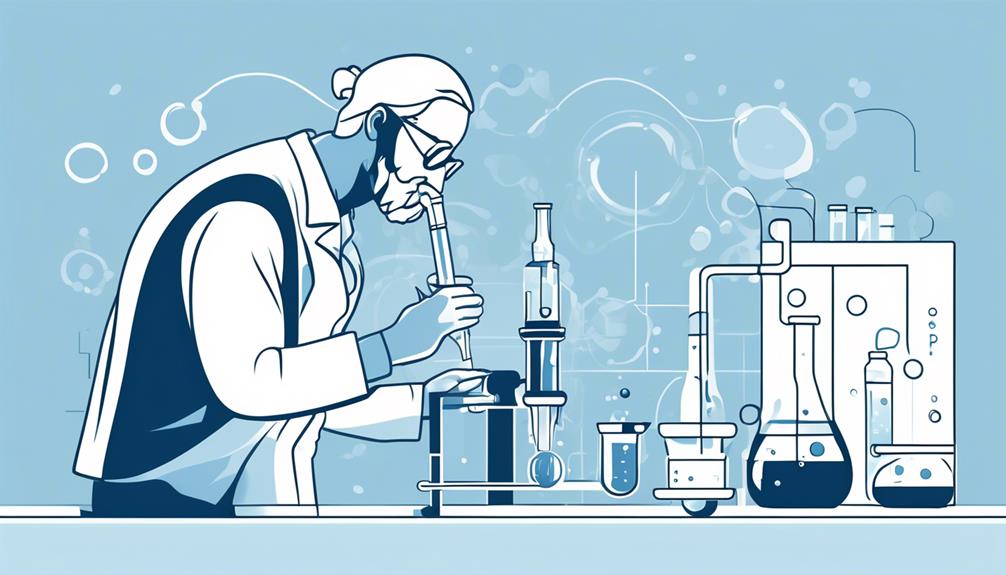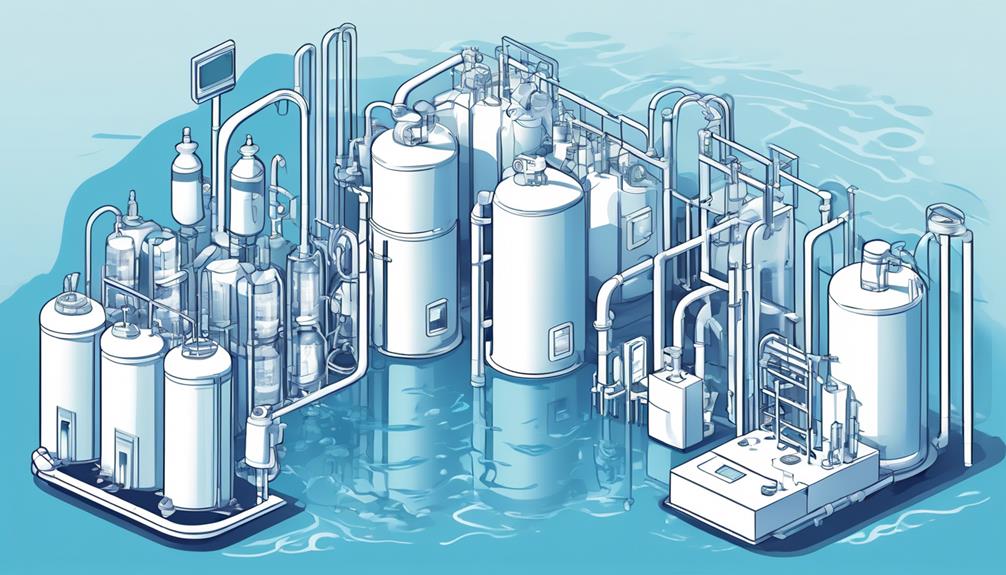Ever wondered what's really in your water?
The EPA's Drinking Water Standards can shed light on the quality of the water flowing from your tap.
From lead lurking in old pipes to disinfectants meant to keep water safe, these regulations play a crucial role in safeguarding your health.
But understanding these standards goes beyond just knowing the basics.
Stay tuned to uncover the key to ensuring that your water is not just clear but truly clean and safe for all.
Key Takeaways
- EPA establishes National Primary Drinking Water Regulations (NPDWRs) to set standards for public water systems.
- Primary Drinking Water Contaminants like antimony, cadmium, and fluoride can pose serious health risks if not regulated.
- Compliance with Maximum Contaminant Levels (MCLs) is crucial for ensuring safe drinking water and protecting public health.
- National Secondary Drinking Water Regulations (NSDWRs) address aesthetic concerns to enhance overall water quality and customer satisfaction.
EPA's Role in Drinking Water Standards
When it comes to drinking water standards, the EPA plays a crucial role in setting and enforcing regulations to ensure the safety and quality of our water supply. The EPA establishes National Primary Drinking Water Regulations (NPDWRs), which are vital standards that public water systems must adhere to. These regulations include a list of Primary Drinking Water Contaminants and their Maximum Contaminant Levels (MCLs), safeguarding against over 90 contaminants. By monitoring states, local authorities, and water suppliers, the EPA ensures that these standards are met to protect public health.
The EPA's Regulatory Determination process identifies unregulated contaminants that may pose risks to public health, focusing on potential candidates for regulation under the Safe Drinking Water Act. While the EPA oversees primary regulations, National Secondary Drinking Water Regulations (NSDWRs) offer guidelines for aesthetic effects and are recommended for water systems to follow. By actively engaging in these regulatory activities, the EPA upholds stringent standards to safeguard the quality of our drinking water supply.
Primary Drinking Water Contaminants List
So, you're ready to explore the Primary Drinking Water Contaminants List.
This list identifies common contaminants and assesses their impact on health.
Understanding these contaminants is crucial for meeting regulatory compliance requirements.
Common Contaminants Identified
Common contaminants identified in the Primary Drinking Water Contaminants List pose various health risks, ranging from intestinal lesions to nerve damage and kidney problems. Water contaminated with antimony can cause intestinal lesions, while cadmium may lead to kidney damage.
Copper in drinking water can result in gastrointestinal distress and potential long-term liver or kidney issues. Cyanide exposure through water consumption can have serious health consequences like nerve damage or thyroid problems.
Additionally, fluoride in water can cause bone disease and mottled teeth. It's crucial for public health that regulations on drinking water quality are strictly enforced to prevent these harmful health effects and ensure safe drinking water for all.
Health Impact Assessment
To understand the health impact of contaminants in the Primary Drinking Water Contaminants List, it's essential to recognize the various risks associated with substances like antimony, cadmium, copper, cyanide, and fluoride.
- Antimony: Causes intestinal lesions.
- Cadmium: Leads to kidney damage.
- Copper: Can cause gastrointestinal distress and long-term liver or kidney damage.
- Cyanide: May result in nerve damage or thyroid problems.
- Fluoride: Can cause bone disease and mottled teeth.
These substances can have detrimental effects on public health when present in public drinking water. It's crucial for public water systems to monitor and regulate these levels to ensure compliance with the National Primary Drinking Water regulations and protect public health.
Regulatory Compliance Requirements
In ensuring compliance with the National Primary Drinking Water Regulations, understanding the Regulatory Compliance Requirements for the Primary Drinking Water Contaminants List is essential for safeguarding public health. Water systems must adhere to the Maximum Contaminant Levels (MCLs) set for various contaminants in drinking water to ensure its safety.
These regulatory compliance requirements are crucial in maintaining high water quality standards and protecting public health. The Safe Drinking Water Act mandates these standards to guarantee that water systems across the country provide clean and safe drinking water.
Secondary Drinking Water Regulations Overview
A total of 15 contaminants, affecting the aesthetics of water such as taste, color, and smell, are covered under the National Secondary Drinking Water Regulations (NSDWRs). These regulations serve to enhance the quality of water beyond health-related concerns, ensuring a more pleasant drinking experience for consumers.
Here's a quick rundown of the key points regarding Secondary Drinking Water Regulations:
- NSDWRs are guidelines recommended by the EPA to manage non-health-related water issues.
- They aim to protect public health by addressing taste, color, and smell concerns in drinking water.
- Compliance with NSDWRs isn't mandatory for public water systems but is highly encouraged.
- Water treatment plays a crucial role in maintaining the aesthetic quality of water by managing levels of contaminants.
- Following NSDWRs can lead to improved overall water quality and customer satisfaction in public water systems.
Understanding and adhering to these regulations can contribute to a better overall drinking water experience while ensuring the public's health and well-being.
Unregulated Water Contaminants Explanation

So, let's talk about those sneaky unregulated water contaminants – antimony, cadmium, copper, and more. These little troublemakers can mess with your health if not kept in check.
Time to see how they can sneak into your water and what risks they bring along!
Harmful Contaminants Overview
Discover the hidden dangers lurking in your water supply with a closer look at unregulated water contaminants. Understanding these contaminants is crucial for safeguarding your health. Here's a simplified overview:
- Drinking Water Contaminant Candidate: Substances that are being considered for regulation under the SDWA.
- Maximum Contaminant Levels: The highest concentration of a contaminant allowed in water by the Federal standards.
- Primary Drinking Water Regulations: Regulations that set legally enforceable standards for contaminants in drinking water.
- Consumer Confidence Report: An annual report that provides information on the quality of your drinking water.
- Federal: The EPA establishes and enforces the standards under the SDWA to ensure safe drinking water for all.
Stay informed and stay safe by understanding these key aspects of water contamination.
Health Risks Associated
Uncovering the health risks linked to unregulated water contaminants reveals a range of potential dangers that could impact your well-being significantly. Contaminants like antimony, cadmium, and mercury pose various health risks, from gastrointestinal distress to kidney damage.
Disinfectants such as chloramine and chlorine may lead to anemia and nervous system effects. Exposure to lead, whether from plumbing or natural sources, can result in developmental delays in children and kidney problems in adults.
The National Primary Drinking Water Regulations monitor specific contaminants like coliforms and E. coli to ensure safe drinking water. Water treatment techniques certify levels of acrylamide and epichlorohydrin to prevent exceeding limits.
Safeguarding human health from these unregulated contaminants necessitates stringent adherence to regulated drinking water standards and treatment practices.
PFAS Regulation Rulemaking Summary
The PFAS Regulation Rulemaking Summary provides a comprehensive overview of EPA's efforts to regulate PFAS in drinking water. Here are some key points to help you understand this complex topic:
- Health Impacts: The summary outlines the health risks associated with PFAS exposure and proposed features of PFAS drinking water regulation.
- Co-Occurrence and Hazard Assessment: It includes information on PFAS co-occurrence and hazard assessment.
- Public Participation: Details about the public participation and input processes are highlighted in the summary.
- Background and Applicability: The document delves into the background, definitions, and applicability of PFAS, covering its chemistry, production, uses, and entities affected by the regulation.
- eCFR Overview: Insights into the online version of the Code of Federal Regulations, user functionalities, and the relevance of Title 40 to environmental protection are provided.
This summary serves as a crucial guide to understanding the regulations surrounding PFAS in public water systems and community water supplies, ensuring the maintenance of primary standards in drinking water.
Preliminary Regulatory Determinations for PFAS

Exploring the regulatory landscape for PFAS involves assessing the impact of man-made chemicals on various products and proposing measures to enhance health safety standards. The EPA is currently making preliminary regulatory determinations for additional PFAS, which are commonly found in drinking water and the environment. These chemicals are a concern due to their potential risks to public health.
The proposed features of PFAS drinking water regulation include setting maximum contaminant levels (MCLs) for PFAS and conducting health risk reduction assessments. Monitoring requirements are also being proposed to detect PFAS in water systems and ensure compliance with the legally enforceable standards.
PFAS often co-occur in groundwater, emphasizing the need for stringent regulations to protect public health. The EPA is working towards establishing a margin of safety by regulating PFAS levels in parts per trillion, aiming to address the health risks associated with these synthetic chemicals effectively.
Stay informed and participate in the process to contribute to the development of robust PFAS regulations.
Approaches to MCLG Derivation for PFAS
Consider the various scientific research and data utilized by the EPA in deriving MCLGs for PFAS. When it comes to deriving Maximum Contaminant Level Goals (MCLGs) for PFAS, the EPA employs specific approaches that are crucial for safeguarding public health and drinking water standards.
- Toxicological Data: The EPA utilizes toxicological data to understand the health impacts of PFAS exposure.
- Risk Assessment Methodologies: Risk assessment methodologies play a vital role in determining safe levels of PFAS in drinking water.
- Exposure Routes: Different ways in which individuals can come into contact with PFAS are considered during MCLG derivation.
- Population Characteristics: Factors such as age, gender, and health status of the population are taken into account.
- Public Input: The EPA actively seeks input from the public and conducts comprehensive scientific assessments to set MCLGs that prioritize public health protection.
Monitoring and Compliance Requirements Breakdown

Discover the essential steps for monitoring and complying with EPA's drinking water standards. Public water systems must provide safe drinking water to consumers. To ensure this, water systems must follow specific monitoring and compliance requirements set by the EPA.
Firstly, water systems must regularly monitor various contaminants to guarantee water safety. This involves conducting tests at specified intervals to assess the levels of pollutants in the water. If any contaminant exceeds the EPA's Maximum Contaminant Levels (MCLs), the water system must take immediate action.
Secondly, if pollutants surpass the MCLs, water systems must provide treatment to reduce contaminant levels. This treatment can involve filtration, disinfection, or other purification methods to make the water safe for consumption.
Lastly, to comply with EPA regulations, water systems must follow reporting requirements. They must document all monitoring results and actions taken to address any issues. By adhering to these monitoring and compliance guidelines, public water systems can ensure the delivery of clean and safe drinking water to consumers.
Treatment Technologies for Drinking Water
Treatment technologies for drinking water utilize a combination of filtration, disinfection, and chemical methods to ensure the removal of contaminants for safe consumption. Here are some key points to consider:
- Filtration processes, like activated carbon and membrane filtration, effectively remove particles, bacteria, and impurities from water supplies.
- Disinfection methods such as chlorination and ozonation are crucial for killing disease-causing organisms in drinking water.
- Advanced treatment technologies like UV irradiation and oxidation processes help in eliminating emerging contaminants, ensuring high-quality drinking water.
Compliance with EPA's enforceable standards, like the National Primary Drinking Water Regulations (NPDWRs), is vital for limiting the levels of contaminants in drinking water and safeguarding public health. The use of available treatment technologies is essential to meet these standards and provide safe and clean drinking water for everyone.
Frequently Asked Questions
What Is EPA Standard for Drinking Water?
For drinking water, EPA sets limits on contaminants to keep you safe. Stick to those standards – they're vital for your health. Make sure your water meets the mark for a clean sip!
What Is the EPA Understanding the Safe Drinking Water Act?
When understanding the Safe Drinking Water Act, EPA sees it as a crucial regulation to safeguard public health by limiting contaminant levels. It focuses on disease-causing germs, chemicals, and aesthetic issues in water. Lead exposure poses significant health risks, especially for children.
How Does the EPA Measure Water Quality?
You measure water quality by setting strict standards to limit contaminants, protecting public health. Focus on controlling germs, chemicals, and other harmful substances. Monitor regularly for coliforms, E. coli, and more to ensure safe drinking water.
What Is the Epa's Safe Drinking Water Hotline?
The EPA's Safe Drinking Water Hotline is your go-to for info on standards, regulations, and contaminant health effects. It guides you on lead, disinfectants, and emerging pollutants. Get help understanding legal standards and compliance.
Conclusion
As you navigate the labyrinth of EPA's drinking water standards, remember that each regulation is like a key, unlocking the door to safe and clean water.
Just as a gardener tends to their plants, the EPA tends to our water supply, ensuring it blossoms with health and vitality.
So, embrace these standards as the guardians of our well-being, guiding us through the maze of contaminants towards a refreshing oasis of purity.
Drink deep, and drink safe.
